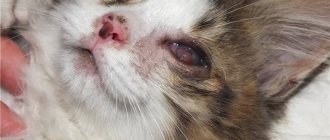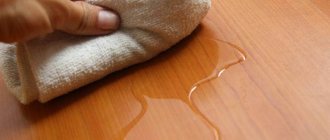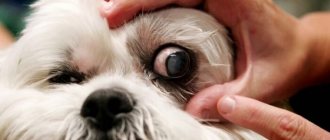When a dog's eyes water, this is not always a warning sign. Slight tearing of the eyes is characteristic of certain breeds and is normal. There are other, more serious causes of wet eyelids. What factors can cause tears from the eyes, what care is needed, what is the treatment? We will answer these questions in our article.
Breed characteristics
In the huge family of canines, there are dog breeds for which teary eyes are a completely normal phenomenon. Brachycephals with a flattened muzzle, long-haired individuals, and those with a large palpebral fissure walk with perpetually wet eyes. Discharge from the eyes is considered normal for them and does not require special treatment, just competent care. The list of breeds includes:
- Saint Bernard;
- bulldogs;
- Bloodhound and Basset;
- chow-chow;
- Cocker Spaniel;
- many decorative breeds (Yorkies, Pekingese);
- Shar Pei;
- bullmastiff;
- Great Danes.
When is excessive tearing normal?
If your dog tears a little when yawning, after sleep, in the cold, in the wind, when a hair gets caught, but after the irritating factor disappears everything goes away, then there is nothing to worry about. The eyes almost always water in brachycephalic dogs (Pekingese, pugs, boxers, etc.), in dogs with an abundance of folds on the muzzle (Neapolitan mastiffs, Shar-Peis, etc.), in those with long hair that gets into the eyes (poodles, shivers). tzu, Yorkshire terriers, etc.). These breeds require special care for their eyes. Their tear ducts need to be kept clean and dry. Wipe daily or several times a day. If necessary, use bleaching agents for wool.
What causes watery eyes?
If a four-legged pet is not one of the breeds for which increased tearfulness is considered normal, then its manifestation should alert the owner. The reason for deviation from the norm may be:
- Allergy. If it is caused by food, then the eyes begin to itch and water. With an allergic reaction to pollen or dust, sneezing is added to the first two symptoms.
- Injuries. Minor injuries to the cornea and eyelids cause irritation of the mucous membrane and increased tearing. Deep wounds are more noticeable, but they are also more difficult to heal.
- Foreign body. The speck gets behind the eyelid and creates a friction effect, which leads to irritation. In an effort to eliminate the obstruction, the dog’s body stimulates increased secretion of moisture in the eye.
- Consumption of sweets. The dog's digestive system cannot absorb glucose. The entry of sugar into the animal’s body causes serious disturbances; against the background of disruptions in the gastrointestinal tract, tearing appears.
- Infectious diseases. For some of them, for example, canine distemper, increased discharge from the eyes is considered one of the characteristic symptoms.
If there is an injury or a foreign body, excessive tearing may occur in one eye.
Skin diseases
The most common problems in Toy Terriers are dandruff and hair loss (baldness).
Baldness
If a dog is going bald, this is a sign of the following diseases and disorders in the body:
- eczema;
- age-related changes;
- metabolic disease;
- improper diet of the dog;
- furunculosis (inflammation of the salt gland of the hair follicle).
Symptoms include symmetrical or focal hair loss in different parts of the body.
Treatment for baldness is prescribed depending on the causes that caused it. To restore hair, the doctor prescribes Trilostane and Metaonine.
Dandruff
The most common causes of dandruff in Toy Terriers:
- too dry air;
- poor nutrition;
- the presence of parasites (fleas, lice, ticks, worms);
- incorrectly selected hygiene products.
Treatment - treat the dog with antiparasitic agents and give deworming medication, and also select grooming products that do not cause dandruff. The products must be suitable for the pet. In addition, humidify the air in the room and comb out the scales with a special brush.
Symptom of tearing in eye diseases
When answering the question of why a dog's eyes are watery, eye diseases should also be included. These include:
- Conjunctivitis, which occurs for a variety of reasons. Eye injury, infection, or a cold can trigger this disease.
- Turning of the eyelids. Normally, the edges of the eyelids fit loosely to the eye; when inverted, they turn inward. Skin hairs and eyelashes touch the cornea, rub against it and irritate it, which leads to the release of tears. An operation is performed to eliminate the defect.
- Eversion of the eyelids. With such a defect, the eyelid turns strongly outward, the lacrimal lake does not cover the lacrimal punctum, and the accumulated moisture freely overflows over the edge of the eyelid.
- Blepharospasm. The animal squints its eyes, the eyelids are tense, the dog blinks frequently. Constant discharge provokes maceration (loosening) of the skin of the eyelids.
- Inflammation of the lacrimal gland or dacryoadenitis.
- Dacryocystitis, in which the lacrimal sac becomes inflamed, causes the eyes to become red and watery. Swelling of the eyelids is clearly visible.
- Neoplasms on the eyelids: benign (fibromas, warts, papillomas, cysts) and malignant (melanomas, sarcomas, carcinomas). The tumor puts pressure on the lacrimal glands, complicates the process of fluid secretion, and tears appear.
- Canaliculitis or inflammation of the tear ducts. The disease is marked by profuse leakage of moisture. It is complicated by purulent inflammation, the eyes swell, and pus comes out along with tears.
Hypersecretion of the lacrimal glands also occurs in diseases such as keratitis, inflammation of the sclera and others. It is difficult for a dog owner to understand the cause of lacrimation based on external signs, so if you notice it, it is better to contact a veterinarian.
How to help your pet at home?
In simple cases, when the pet’s eyes are watery despite their overall healthy appearance, the owner can provide help at home. First, you should inspect the animal:
- Place your pet in front of you. Gently spread your eyelids apart with your fingers. Examine the eye carefully.
- Evaluate the structure of the discharge and the color of the eyelids. Normally they have a pale pink tint.
- Check for the presence or absence of foreign bodies and visible damage.
Now about what to do and what means to use. If you need to rinse your eyes, you should use a sodium chloride solution. It will also help wash away the foreign body.
In order to cope with an allergic reaction to pollen, you need to give your pet Cetirizine. Daily dose – 1 tablet. If you have a food allergy, you need to remove the food that triggers it from your diet.
To eliminate inflammation and itching, you can brew chamomile flowers (1 sachet per glass of hot water). Leave for 15 minutes. Soak a cotton pad in the cooled solution and carefully wipe the animal’s eyes. “Diamond Green” drops are very helpful against swelling.
If after 5 days the problem has not been resolved, you need to show the animal to a specialist.
Attention!
Do not self-medicate if you cannot determine the exact cause of your pet's tearfulness.
What symptoms should you go to the vet for?
We looked at the different causes of tearing. Some of them the dog owner can successfully cope with at home. A mandatory visit to a doctor is necessary if:
- the discharge acquires the structure of purulent exudate;
- the pet's eyes turn red;
- the eyelids are very swollen;
- photophobia appears;
- the lens of the eye becomes white;
- the dog has no appetite, its behavior becomes lethargic;
- the color of the fur around the eyes changes;
- a film appears on the eyeball.
Treatment
The treatment tactics for excessive tearing depend on the cause that caused it. For breeds that have this phenomenon due to their special structure, regular hygienic washing is sufficient. Treatment methods for other negative factors:
- Entropion and eversion of the eyelids are corrected promptly.
- In case of eye injuries, the doctor assesses the degree of damage and prescribes medications. Sometimes stitches are required.
- If tissue maceration occurs, a 1-3% solution of dicaine is instilled. To eliminate pain (for example, when a foreign body enters), antiseptic ointments with 3% novocaine are used.
- For conjunctivitis, it is recommended to use drops of silver nitrate or zinc sulfate. They reduce the volume of secretions and soothe irritation.
- Inflammation is relieved with antibiotic ointments (Tetracycline).
How to put drops in your dog's eyes?
When prescribing eye drops, the doctor assumes that the animal owner must administer them. However, not all dog owners know how to do this correctly. The procedure looks like this:
- First, the pet needs to rinse its eyes. To do this, you need to generously moisten a cotton pad in warm water and gently, without pressing on the eyeball, move it from the outer corner of the eyelid to the inner corner.
- Then take the bottle of medicine in your right hand, and with the fingers of your left hand, pull down the lower eyelid.
- Drop the drug into the space between the eyelid and eye.
- Many drops cause burning and itching, so try to keep your dog in place after the procedure. If the animal begins to shake its head and rub its face with its paw, the medicine will not have time to spread over the eye and will not have a therapeutic effect.
Accustom your pet to the procedure from puppyhood.
Dental care
The fact that the Toy Terrier is a small breed dog does not mean that it has fewer teeth than others. There are as many of them as other breeds. The toy has 20 teeth on the upper jaw and 22 on the lower jaw. An adult healthy dog has 42 teeth.
Between 4 and 6 months after birth, the puppy's baby teeth change. The root of the baby tooth dissolves and the crown becomes loose. By the age of 8 months, the process of changing teeth is completely completed.
Between the ages of 1 and 2 years, your dog may experience loose molars that may fall out.
Causes of loss of molars:
- hardened plaque, which over time destroys the chewing organ;
- advanced gingivitis is a disease that causes inflammation of the gums, leading to loose teeth and tooth loss;
- periodontitis is an inflammation of the gums, accompanied by bleeding, pus and pain.
Dental treatment plan for a toy terrier in a clinic:
- Carrying out diagnostics and taking tests;
- Cleaning teeth, removing tartar, removing decayed and broken teeth;
- Prescription of anti-inflammatory, antiseptic and enzyme drugs to eliminate inflammatory processes;
- If there is no improvement, then antibiotics are prescribed.
Teeth cleaning:
- buy cotton swabs or a children's toothbrush, as well as toothpaste for dogs and a hook for removing tartar;
- If possible, position the dog so that it is comfortable for both you and her. Some people advise placing the baby on your lap;
- walk over your pet's teeth with a cotton swab or toothbrush with toothpaste, moving from the gums to the edge of the tooth. Pay special attention to the painters (far teeth);
- now, if there is plaque, carefully remove it with a hook or an orange stick. If the plaque has already become hard, you will have to visit a veterinarian.
NOTE!
When brushing your teeth, your goal is not to scare your pet. Accustom him to the procedure gradually, talk to him, encourage him.
Prevention
Preventing unexpected tearing is much easier than dealing with it. Here's what veterinarians recommend to prevent the problem:
- When washing your pet, make sure that no detergent gets into your eyes.
- Keep long hair out of the eyes by cutting it or tying it into ponytails with rubber bands.
- Maintain a balanced diet. Do not give the animal foods to which an allergic reaction has been observed.
- Reduce your walking time in windy weather to prevent dust and sand from getting into your eyes. Be sure to wash them after your walk.
- At the slightest suspicion of inflammation, take your pet to a doctor.
By carefully monitoring the pet's condition and regularly carrying out all required hygiene procedures, the owner ensures a happy and healthy life for his pet. Eye diseases are dangerous due to their complications, which is why it is so important to diagnose them in time and carry out the necessary treatment .
Video on how to wipe a dog's eyes
Briefly about the main thing
- Your pet may experience tearing if he has an eye disease, or it may be a sign of a more serious illness, an allergic reaction, or a breed trait.
- It is necessary to carefully monitor the health of the animal so that pathology can be noticed in time and treatment can begin.
- Inspect and clean eyes daily and take good care of your dog.
- You should keep medications for care and treatment in the house, the so-called “eye first aid kit”











